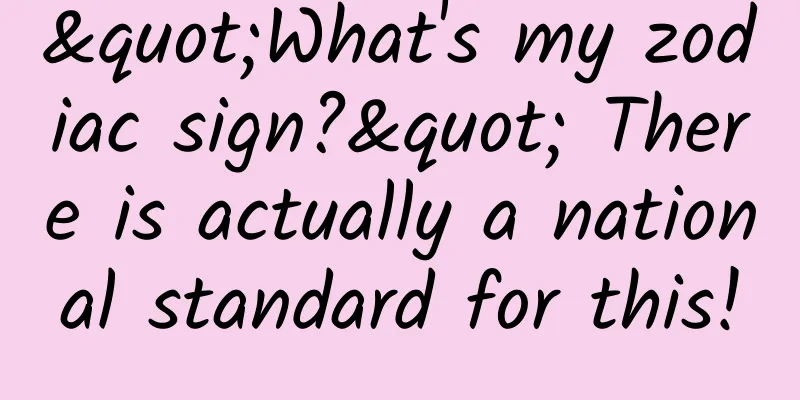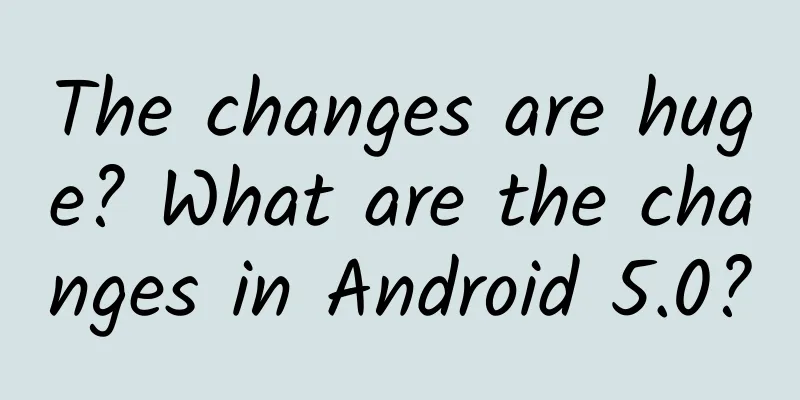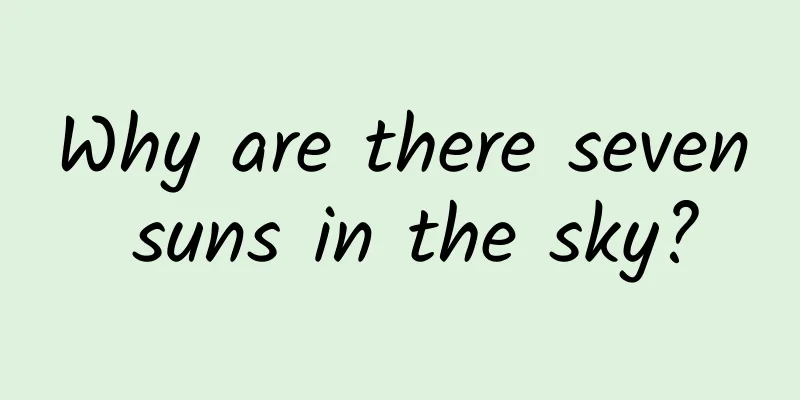"What's my zodiac sign?" There is actually a national standard for this!

|
Whether in daily life or during festivals, many people will discuss the topic of zodiac signs. Some say that the zodiac sign should be calculated from New Year's Day, some think it should start from the first day of the new year, and some think it should start from the beginning of spring. So, which day should it start from? In fact, there is countless documentary evidence for the calendar, and it is not a "salty-sweet battle." Let's talk about it today. Copyright images in the gallery. Reprinting and using them may lead to copyright disputes. Ancient chronology was not easy The Spring Festival is the most important festival for Chinese people, but this situation has not always existed . The "Taichu Calendar" established by Emperor Wu of the Han Dynasty was the earliest calendar to use January 1 as the beginning of the year. Before that, the Qin Dynasty used the "Zhuanxu Calendar" with October 1 as the beginning of the year, and January 1 was just an ordinary month, probably just a day to pay salaries. In the Han Dynasty, the first day of the first month was used as the beginning of the year, but it was just a calendar act. The custom of celebrating the New Year gradually formed in the Wei and Jin Dynasties. Of course, whether to celebrate the New Year or not and the zodiac sign are two different things. In the second year of Emperor Zhang of the Han Dynasty (85 AD), the court ordered the implementation of the sexagenary cycle throughout the country. That’s why we have the writing of “Jia Shen Year” and “Yi Chou Year” on the calendar today. To give a brief introduction, the Ganzhi calendar is based on the ten Heavenly Stems (Jia, Yi, Bing, Ding, Wu, Ji, Geng, Xin, Ren, and Gui) and the twelve Earthly Branches (Zi, Chou, Yin, Mao, Chen, Si, Wu, Wei, Shen, You, Xu, and Hai), which are combined in pairs and counted downwards. The first year is Jiazi, the second year is Yichou, and so on. Because there are 10 in one group and 12 in another, a cycle lasts 60 years. Here is a question for you to think about: A says he was born in the year of Yiyou, and B says he was born in the year of Dingwu. Which one is lying? The answer is at the end of the article. This question is quite interesting, and I suggest you think about it. Sixty years is basically the upper limit of an emperor's reign, so combined with the reign title, the year can be accurately marked. For example, if I was born in the year of Renzi during the Yongzheng reign, that would be 1732. However, for illiterate people, the Heavenly Stems and Earthly Branches are still too complicated, so we simply use the twelve zodiac animals to correspond to the twelve earthly branches. It is very convenient for everyone to just say what their zodiac sign is. If you are a rooster, I count as a rabbit, and we will understand once we subtract them. The 12-year cycle is also suitable and will not cause confusion - for example, if a person is 1, 13, 25, or 37 years old, they are all born in the Year of the Pig. You can tell which cycle they belong to by looking at their appearance. What? It is hard to tell the difference between a 37-year-old and a 49-year-old? How many people in ancient times lived to be 49!? Why are there these twelve zodiac signs? The earliest record of "zodiac signs" discovered so far appeared in "Book of Southern Qi·Five Elements": "Donghun Hou's sign is pig... Liang Wang's sign is dragon...", which is credible evidence. It shows that at the latest in the Southern and Northern Dynasties, the use of zodiac signs to refer to people was already widely used. As to why these twelve animals are used, there are different opinions in the academic community. Some say that they are derived from astronomical phenomena, and there is a corresponding relationship between the twelve zodiac animals and the twenty-eight mansions; some say that they are derived from early animal worship; many great scholars such as Guo Moruo say that the twelve zodiac animals come from the Western Regions or India. These theories seem to make some sense, but there is no fundamental evidence. Earthly branches and corresponding animals in Qin and Han bamboo slips In fact, this is still a natural process that took shape slowly. The zodiac can basically be divided into three groups: those related to life, such as cattle, sheep, chickens, and rats; those that are dangerous, such as tigers, snakes, and the elephants and ghosts in the Han Dynasty bamboo slips above; and the dragon, which is a magical thing that does not exist or has become extinct. This can also be regarded as an ancient "popular science tip". By mastering these animals, children will know which ones can be eaten, which ones can be raised, and which ones should be avoided. As for "dangerous goods" such as crocodiles, lions, and leopards, they were not common in the lives of ancient Chinese. The twelve zodiac figurines from the Tang Dynasty, Image source: National Museum Surprisingly, there are many ancient countries in the world that have similar cultures to the "zodiac", and there are often twelve of them. For example, the Babylonian zodiac has the falcon, the Greek zodiac has the flamingo, the Indian zodiac has the lion, and the Burmese zodiac has the guinea pig. Of course, they are all formed slowly according to the animal conditions in various places. The Greek word for the zodiac is "zodiac", which has the same root as the word "zoo". Where does the controversy come from? After reading the above text, you may ask, isn't the fact quite clear? The ancient Chinese zodiac calendar certainly does not use the current Western calendar New Year's Day as the standard, let alone the inappropriate beginning of spring. That's right, the use of the Chinese zodiac calendar was introduced into my country long before the Gregorian calendar, so the statement that "1983 is the Year of the Pig" is simply not true. The reason for this controversy among the people is mainly due to Yuan Shikai. After Yuan Shikai became president, he abolished the old calendar and promoted the new calendar. This is not a big deal. The key point is that he kept changing the name. The Lunar New Year, which was originally called "New Year's Day", was renamed "Spring Festival", giving up "New Year's Day" to the solar calendar; "Lichun", which was originally widely known as "Spring Festival", could no longer be called "Spring Festival", but could only be called "Lichun". These three names caused a lot of confusion, so much so that the rumor spread and involved the calculation of the zodiac. The other pot is even more interesting. Did ancient people use the beginning of spring as the beginning of the year? Yes, there was, but it was not official and belonged to "folk science". After summarizing the theories of his predecessors, Xu Ziping of the Northern Song Dynasty created a set of "Zi Ping Shu", which took the beginning of spring as the beginning of the year. This could not be called feudal superstition at the time, and it was also a kind of research by the ancients, but it changed later. The most famous concept of "Zi Ping Shu" is "Eight Characters", you can taste it. Therefore, those who like fortune-telling and character divination in later generations, as well as **a few traditional culture enthusiasts and practitioners of traditional Chinese medicine who have "gone astray", love to talk about "the beginning of the year". In a good way, it is to pass on culture, and in a bad way, it is to be different and show their own extraordinaryness, so as to achieve some economic or other purposes. Because these people are often the best at speaking with certainty, and the listeners only half understand, so this school of thought has an increasing influence. Actually, there is nothing to argue about. Next time someone tells you that New Year's Day or the Beginning of Spring is the first day of your zodiac sign, just give him these three pictures. Swipe left to see more This is our country's national standard for this issue. By the way, do you remember the thinking question? Announce the answer: B is lying . Although there are 10 and 12 Heavenly Stems and Earthly Branches respectively, because they are both even numbers, the sequential arrangement and circulation does not produce all 120 combinations, but only 60. This is the concept of the lowest common multiple! Odd Heavenly Stems and even Earthly Branches will not meet, and vice versa, so there is no such year as Dingwu. If you can't figure it out, take a look at the following table: Image source: Wikipedia Planning and production Author丨Lao Xin popular science author Reviewer: Wang Hongzhi, Associate Professor, School of Humanities, Shanghai Normal University Editor: Zhong Yanping Proofread by Xu Lailinlin The cover image and the images in this article are from the copyright library Reprinting may lead to copyright disputes |
Recommend
Android 12 crash: Multiple Google Pixel devices crashed and battery life reduced after update
[[430481]] On October 22, according to PhoneArena...
For the first time! Chinese scientists discovered the chemical remains of the first generation of supermassive stars
(Original title: Appointment with the Starry Sky丨...
A new method to improve the survival rate of Android application processes (Part 1)
[[179902]] Basics Android process priority 1 Gene...
Why did Huawei and Xiaomi choose e-commerce to enter the Indian market?
In 2007, two young men, Sachin Bansal and Binny B...
My investment philosophy is based on cyclicality.
The clock theory divides the economic cycle into ...
Subverting cognition: It only takes 1 to 3 seconds! How can humans "smell" things so quickly?
Author: Xu Yahui Duan Yuechu Human olfactory perc...
The low profit margins of hardware force the industry to accelerate development; long-term traffic operations explore new channels for trillion-dollar OTT marketing
With the sweeping wave of large-screen smart livi...
The most useful "bucket waist" in the world can hold 2 tons of water!
In the magical nature, there are many kinds of cr...
Artificial Intelligence in AR
In March this year, the Shanghai Municipal Commis...
"Nature" releases seven major scientific events worth paying attention to in 2022!
Although the COVID-19 pandemic is still raging th...
Should I charge my phone when it’s fully charged or when it’s halfway charged? I finally figured it out
Charging a mobile phone is an everyday operation ...
Case analysis: How can a product achieve user growth?
In recent years, the popularity of online educati...
iOS 12 first public beta released to see if it is worth upgrading
Apple has officially pushed the first public beta...
What do animals do when the weather gets cold? They have some unique ways to survive the winter!
In the cold winter, people often shiver with cold...
Is it true that looking into each other's eyes for 60 seconds can make people fall in love with each other?
There are often such clips in movies and TV drama...









